5 March 1999
On Board the Department of Conservation Vessel TOHORA
South Bay, Kaikoura, New Zealand
Listening to the Whales - Part Two

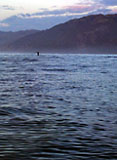 As we neared our destination, we were presented
with a sight that I have to admit made my heart
race a good deal faster than normal. There,
about 300 meters ahead of us, was a large,
solitary sperm whale swimming slowly along at the
surface, exhaling huge blasts of spray. We
watched him for nearly ten minutes when both
Keith and Bernard, both of whom have seen many
more whales that I have, said that the whale was
ready to dive. Sure enough, after the next blow
the whale arched his back, raised his flukes high
above the surface and dove head first into the
depths of Kaikoura Canyon where for the next
forty five minutes he would search the darkness
for food - including the giant squid.
As we neared our destination, we were presented
with a sight that I have to admit made my heart
race a good deal faster than normal. There,
about 300 meters ahead of us, was a large,
solitary sperm whale swimming slowly along at the
surface, exhaling huge blasts of spray. We
watched him for nearly ten minutes when both
Keith and Bernard, both of whom have seen many
more whales that I have, said that the whale was
ready to dive. Sure enough, after the next blow
the whale arched his back, raised his flukes high
above the surface and dove head first into the
depths of Kaikoura Canyon where for the next
forty five minutes he would search the darkness
for food - including the giant squid.
Since this was obviously a good place to listen
to the whales as they dove, Bernard decided that
we should set out the hydrophone array and start
recording. The actual details of how this is
done and how the data are interpreted and will be
used in our search for the giant squid will be
described by Bernard in another journal. Once we
selected our site, Keith shut off the engine and
Bernard started to open the large plastic storage
boxes that held all of the line, floats,
hydrophones, computers and all sorts of other
bits and pieces that we were going to use.
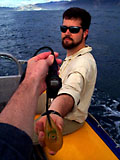
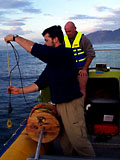 The first thing that Bernard did was to set the
digital wristwatch that was strapped to the line
just above the lowest hydrophone, which by the
way looks like a large, amber colored gumdrop.
Bernard told me that after considering all sorts
of complicated and expensive means to calibrate
the timing of the hydrophone array, they decided
that a cheap digital wristwatch with an alarm was
the best solution. Bernard carefully lowered the
hydrophone over the side and slowly lowered it
down to 40 meters depth. When that depth was
reached, Bernard
clipped a small white buoy to
the line and continued to let more line out until
it streamed about 100 meters downstream of our
boat.
The first thing that Bernard did was to set the
digital wristwatch that was strapped to the line
just above the lowest hydrophone, which by the
way looks like a large, amber colored gumdrop.
Bernard told me that after considering all sorts
of complicated and expensive means to calibrate
the timing of the hydrophone array, they decided
that a cheap digital wristwatch with an alarm was
the best solution. Bernard carefully lowered the
hydrophone over the side and slowly lowered it
down to 40 meters depth. When that depth was
reached, Bernard
clipped a small white buoy to
the line and continued to let more line out until
it streamed about 100 meters downstream of our
boat.
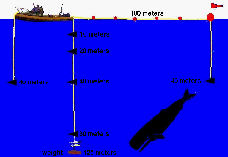
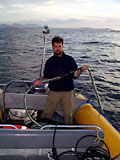 Bernard checked that the first hydrophone was
working (which it was) and then we turned our
attention to deploying the second hydrophone
array. This one was supported by a much heavier
line than the first and had four hydrophones on
it (10, 20, 40 and 80 meters depth) as opposed to
just one on the first array. And then, as if
this wasn't enough to handle, Bernard attached a
very heavy weight which in its prior life was a
railway hammer
to an extra 40 meters of line
which he then tied to the very bottom. Because
of the strong currents in the Canyon, Bernard
found that he needed to add this extra line and
weight t make sure that the hydrophones were as
close to vertical as possible.
Bernard checked that the first hydrophone was
working (which it was) and then we turned our
attention to deploying the second hydrophone
array. This one was supported by a much heavier
line than the first and had four hydrophones on
it (10, 20, 40 and 80 meters depth) as opposed to
just one on the first array. And then, as if
this wasn't enough to handle, Bernard attached a
very heavy weight which in its prior life was a
railway hammer
to an extra 40 meters of line
which he then tied to the very bottom. Because
of the strong currents in the Canyon, Bernard
found that he needed to add this extra line and
weight t make sure that the hydrophones were as
close to vertical as possible.
 For this deployment, Bernard used only two
hydrophone lines. At other times, a third
hydrophone is hung from the bow of the boat at a
depth of 40 meters. With the hydrophones in the
water, Bernard took out his notebook and recorded
a few key facts about the day, our location
(which we continuously monitor using a small,
hand held Global Positioning System unit)
and the location of the whale we were listening to.
For this deployment, Bernard used only two
hydrophone lines. At other times, a third
hydrophone is hung from the bow of the boat at a
depth of 40 meters. With the hydrophones in the
water, Bernard took out his notebook and recorded
a few key facts about the day, our location
(which we continuously monitor using a small,
hand held Global Positioning System unit)
and the location of the whale we were listening to.
 The resident whales in Kaikoura have all been given
names by the Whale Watchtm
folks. In this
particular case, the whale that we were listening
to was named "Droopy Flukes". In talking with
Bernard, I learned that the whales stay at the
surface for precisely 10 minutes and then dive.
And then at exactly 20 seconds into the dive, not
15 and not 25, the whales start emitting the
sonar pings that we were here to record. Rather
than record them on a traditional tape recorder,
Bernard uses a computer
that records each of the
hydrophone's signals (5 in this case, or 6 when
the third hydrophone array is used) at a data
rate of 10 megabytes per minute. With a typical
dive lasting 45 minutes, the data volume becomes
quite significant. After a few hours of
recording, you can begin to imagine the volume of
data that has to be analyzed.
The resident whales in Kaikoura have all been given
names by the Whale Watchtm
folks. In this
particular case, the whale that we were listening
to was named "Droopy Flukes". In talking with
Bernard, I learned that the whales stay at the
surface for precisely 10 minutes and then dive.
And then at exactly 20 seconds into the dive, not
15 and not 25, the whales start emitting the
sonar pings that we were here to record. Rather
than record them on a traditional tape recorder,
Bernard uses a computer
that records each of the
hydrophone's signals (5 in this case, or 6 when
the third hydrophone array is used) at a data
rate of 10 megabytes per minute. With a typical
dive lasting 45 minutes, the data volume becomes
quite significant. After a few hours of
recording, you can begin to imagine the volume of
data that has to be analyzed.

 Bernard connected a small speaker to the computer
so that we could actually listen to the sound of
the whales. After several hours of listening to
the whales of Kaikoura Canyon, the best
description that I can give of
what it sounded like was to imagine a portable radio filled with
background static through which you are listening
to the sound of a steam-driven pile driver
hammering things once per second. Although the
patterns of the sounds would change periodically
(as will be described in a later journal by Bernard), the regular pattern over such a long period of time really amazed me.
Bernard connected a small speaker to the computer
so that we could actually listen to the sound of
the whales. After several hours of listening to
the whales of Kaikoura Canyon, the best
description that I can give of
what it sounded like was to imagine a portable radio filled with
background static through which you are listening
to the sound of a steam-driven pile driver
hammering things once per second. Although the
patterns of the sounds would change periodically
(as will be described in a later journal by Bernard), the regular pattern over such a long period of time really amazed me.
<-- Return to Part 1 or Go to Part 3 -->

 As we neared our destination, we were presented
with a sight that I have to admit made my heart
race a good deal faster than normal. There,
about 300 meters ahead of us, was a large,
solitary sperm whale swimming slowly along at the
surface, exhaling huge blasts of spray. We
watched him for nearly ten minutes when both
Keith and Bernard, both of whom have seen many
more whales that I have, said that the whale was
ready to dive. Sure enough, after the next blow
the whale arched his back, raised his flukes high
above the surface and dove head first into the
depths of Kaikoura Canyon where for the next
forty five minutes he would search the darkness
for food - including the giant squid.
As we neared our destination, we were presented
with a sight that I have to admit made my heart
race a good deal faster than normal. There,
about 300 meters ahead of us, was a large,
solitary sperm whale swimming slowly along at the
surface, exhaling huge blasts of spray. We
watched him for nearly ten minutes when both
Keith and Bernard, both of whom have seen many
more whales that I have, said that the whale was
ready to dive. Sure enough, after the next blow
the whale arched his back, raised his flukes high
above the surface and dove head first into the
depths of Kaikoura Canyon where for the next
forty five minutes he would search the darkness
for food - including the giant squid.







